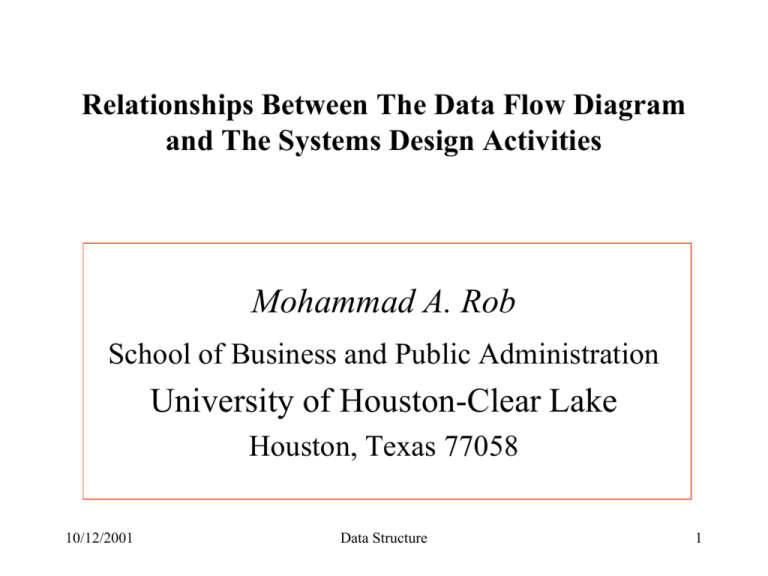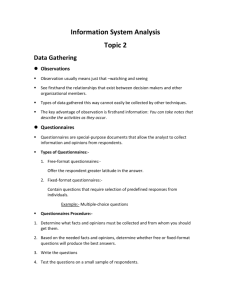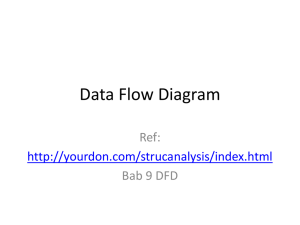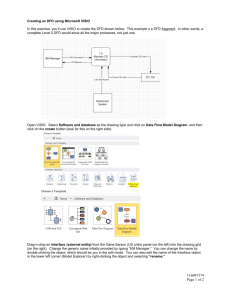Relationship Between Analysis & Design
advertisement

Relationships Between The Data Flow Diagram and The Systems Design Activities Mohammad A. Rob School of Business and Public Administration University of Houston-Clear Lake Houston, Texas 77058 10/12/2001 Data Structure 1 Introduction • Data-flow diagramming technique (DFD) is used to understand the business processes of a system. 10/12/2001 Data Structure 2 Relationships Between The Data Flow Diagram and The Systems Design Activities • The data flow diagrams also contain information on the four essential components of a systems, namely – the input Processes Inputs Outputs – output – program modules – data storage Data 10/12/2001 Data Structure 3 • We modify the system concept such that its components are within the dotted-line boundary and the external entities (of DFD) interact with the system through the input and output components. 10/12/2001 Data Structure 4 Relationships Between The Data Flow Diagram and The Systems Design Activities • The goal of a systems analyst is to extract necessary information on the input, program modules, data storage, and output components of a system from the data flow diagrams and then design these components . 10/12/2001 Data Structure 5 Relationships Between The Data Flow Diagram and The Systems Design Activities Data Dictionary • First, a data dictionary is created that describes all data flows, data stores, processes, and external entities of the data-flow diagrams. • The data-flows and data stores are then expanded to describe the data structure associated with each of these components. • Each data structure is further expanded to describe the data elements that comprise the data structure. 10/12/2001 Data Structure 6 Relationships Between The Data Flow Diagram and The Systems Design Activities Data Storage Design • Once the data-structures associated with all data stores in the data flow diagrams are defined, they are organized to understand the relationships between the data elements of various data stores. • Files and databases that comprise the data storage component of a system, are designed on the basis of these data stores. 10/12/2001 Data Structure 7 Relationships Between The Data Flow Diagram and The Systems Design Activities Data Storage Design • Entity-relationship diagrams are commonly used for data modeling or database design. • The data stores in the data-flow diagram become the entities in the entity-relationship diagram. Data Store 10/12/2001 Entity Data Structure 8 Relationships Between The Data Flow Diagram and The Systems Design Activities Input Design • The data flows originated from the external entities and ending to the processes in a data flow diagram carry information on the input components of a system. • The data structures associated with the input data flows are described in the data dictionary. • These data structures are used to design the data-entry forms or screens of a system. 10/12/2001 Data Structure 9 Relationships Between The Data Flow Diagram and The Systems Design Activities Output Design • The data flows originated from the processes and ending to the external entities in a data flow diagram carry information on the output components of a system. • The data structures associated with the output data flows are described in the data dictionary. • These data structures are used to design the output reports or statements of a system. 10/12/2001 Data Structure 10 Relationships Between The Data Flow Diagram and The Systems Design Activities Program Modules Design • The business processes in the data flow diagrams become the program modules of a system. • Structure charts are commonly used to illustrate the relationships between the program modules of a system • The levels of a structure chart typically correspond to the levels of a data flow diagram Context-level 0-level 10/12/2001 Data Structure Sub Main Sub Sub 11 Relationships Between The Data Flow Diagram and The Systems Design Activities • It should be clear that the data dictionary of a system is solely based on the data flow diagram, but the design activities are based on both the “data flow diagrams” and the “data dictionary” • Understanding this relationship is not obvious when the individual design activities and their associated tools are presented as independent activity 10/12/2001 Data Structure 12 Relationships Between The Data Flow Diagram and The Systems Design Activities 10/12/2001 Data Structure 13 Illustration of the Relationship Between The DFD and Data Dictionary • The data dictionary of a system requires three stages of descriptions: – Describe all components of the data flow diagrams – Describe the data structures associated with the data flow and data store – Describe data elements associated with the data structure 10/12/2001 Data Structure 14 10/12/2001 Data Structure 15 Illustration of the Relationship Between The DFD and Data Dictionary 10/12/2001 Data Structure 16 Illustration of the Relationships Between The DFD and The Systems Components • There are many components in a data flow diagram. • All these components collectively participate in the design activities of the system components • But only a set of these data flow diagram components are used to design an individual component of a system. 10/12/2001 Data Structure 17 Illustration of the Relationships Between The DFD and The Systems Components • In order to clarify the relationship between the DFD and the system components, we rearrange the data flow diagram components to fit into the system model. 10/12/2001 Data Structure 18 10/12/2001 Data Structure 19 Illustration of the Relationships Between The DFD and The Systems Components • We move all data store components of the DFD and enclose within the boundary of the data storage component of a system. • All external entities of the DFD are enclosed in two external entities of the system. • The rest of the DFD components, which include all the processes and the data flows are enclosed in a boundary of program modules component of a system. 10/12/2001 Data Structure 20 10/12/2001 Data Structure 21 Illustration of the Relationships Between The DFD and The Systems Components • With the illustration, the knowledge of the design activities becomes simple. • All data stores in the data flow diagram participate in the data storage design – for files and/or database. • All data flows originating from the external entities and leading towards the program modules are considered for the input design. 10/12/2001 Data Structure 22 Illustration of the Relationships Between The DFD and The Systems Components • Similarly, all data flows originating from the program modules and leading to the external entities are considered for the design of the output components. • All the processes and data flows enclosed by the outer boundary of the program modules are considered for program design. 10/12/2001 Data Structure 23






![Chapter 4 – Answers [Question #1] What is UML? [Your response](http://s3.studylib.net/store/data/009213150_1-1887d42e0801f650ce2c0a5501545943-300x300.png)
